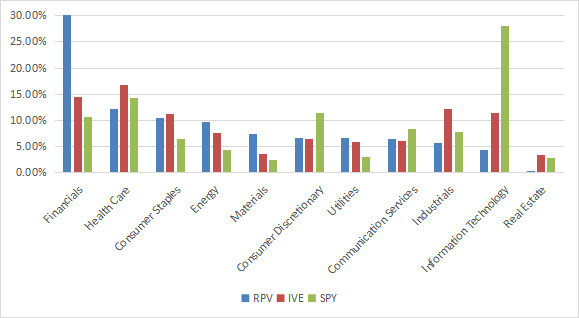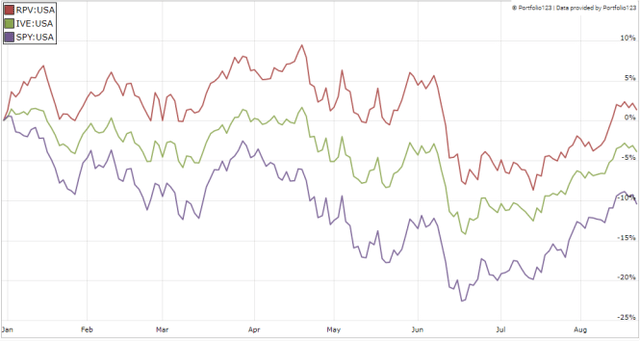Brankospejs/iStock via Getty Images
RPV Strategy And Portfolio
The Invesco S&P 500 Pure Value ETF (NYSEARCA:RPV) has been tracking the S&P 500 Pure Value Index since March 2006. It has 121 holdings, an expense ratio of 0.35% and a 12-month distribution yield of 1.96%.
As described in the prospectus by Invesco, S&P 500 stocks are assigned two scores for value and growth. The value score is based on three ratios: book-value-to-price, earnings-to-price, and sales-to-price. The growth score is based on the three-year sales per share growth, the three-year earnings yield change, and the 12-month share price return. The S&P 500 Pure Value Index selects stocks with the best value score, excluding those demonstrating both value and growth characteristics. Constituents with higher value scores receive greater weights.
In this article, RPV will be compared to the iShares S&P 500 Value ETF (IVE) and the SPDR S&P 500 ETF (SPY).
Regarding the usual valuation ratios, RPV is much cheaper than IVE, which is much cheaper than SPY:
|
RPV |
IVE |
SPY |
|
|
Price/Earnings TTM |
10.48 |
16.19 |
20.15 |
|
Price/Book |
1.36 |
2.5 |
3.85 |
|
Price/Sales |
0.68 |
1.69 |
2.55 |
|
Price/Cash Flow |
7.34 |
11.84 |
15.85 |
Source: Fidelity
RPV holds 120 stocks. The top 10 holdings represent 19.6% of the portfolio value. The next table lists their weights and valuation ratios. No holding weighs more than 2.34%, so risks related to individual stocks are low.
|
Ticker |
Name |
Weight% |
P/E ttm |
P/E fwd |
P/Sales |
P/Book |
P/FCF |
Yield |
|
Cigna Corp |
2.34 |
17.47 |
12.76 |
0.52 |
2.03 |
13.25 |
1.53 |
|
|
Marathon Petroleum Corp |
2.21 |
6.79 |
4.86 |
0.34 |
2.05 |
6.14 |
2.31 |
|
|
Berkshire Hathaway Inc |
2.18 |
59.30 |
21.01 |
2.27 |
1.42 |
31.56 |
0 |
|
|
Valero Energy Corp |
2.01 |
6.82 |
4.89 |
0.31 |
2.28 |
8.11 |
3.31 |
|
|
Archer-Daniels-Midland Co |
1.96 |
13.75 |
12.83 |
0.53 |
2.03 |
62.24 |
1.83 |
|
|
Prudential Financial Inc |
1.92 |
19.16 |
10.39 |
0.60 |
1.37 |
4.59 |
4.64 |
|
|
Metlife Inc. |
1.84 |
16.79 |
9.08 |
0.80 |
1.48 |
4.02 |
2.97 |
|
|
The Allstate Corporation |
1.83 |
39.38 |
24.83 |
0.71 |
1.96 |
12.39 |
2.61 |
|
|
Centene Corp |
1.66 |
30.83 |
16.99 |
0.41 |
2.15 |
9.45 |
0 |
|
|
WestRock Company |
1.61 |
11.87 |
8.70 |
0.51 |
0.93 |
10.51 |
2.40 |
Financials are by far the heaviest sector, with about 30% of asset value. Compared to IVE and SPY, RPV massively overweights financials, materials, and to a lesser extent energy and utilities. It underweights technology, industrials and almost ignores real estate.
Sector weights (chart: author: data: Fidelity)
Since inception (03/01/2006), RPV has lagged SPY by 1.1 percentage point in annualized return, and it beats IVE by the same gap. It shows a much higher risk than the two other funds in drawdown and volatility (standard deviation of monthly returns).
|
Total Return |
Annual Return |
Drawdown |
Sharpe ratio |
Volatility |
|
|
RPV |
286.43% |
8.56% |
-74.86% |
0.42 |
23.65% |
|
IVE |
227.46% |
7.47% |
-61.61% |
0.45 |
16.30% |
|
SPY |
356.36% |
9.66% |
-55.42% |
0.59 |
15.61% |
Data calculated with Portfolio123
However, RPV has been leading the pack in 2022 to date:
RPV vs IVE vs SPY year-to-date (Portfolio123)
Comparing RPV With My Dashboard List Model
The Dashboard List is a list of 80 stocks in the S&P 1500 index, updated every month based on a simple quantitative methodology. All stocks in the Dashboard List are cheaper than their respective industry median in Price/Earnings, Price/Sales and Price/Free Cash Flow. After this filter, the 10 companies with the highest Return on Equity in every sector are kept in the list. Some sectors are grouped together: energy with materials, communication with technology. Real estate is excluded because these valuation metrics don’t work well in this sector. I have been updating the Dashboard List every month on Seeking Alpha since December 2015, first in free-access articles, then in Quantitative Risk & Value.
The next table compares RPV performance since inception with the Dashboard List model, with a tweak: the list is reconstituted annually instead of monthly to make it comparable to a passive index.
|
Total Return |
Annual Return |
Drawdown |
Sharpe ratio |
Volatility |
|
|
RPV |
286.43% |
8.56% |
-74.86% |
0.42 |
23.65% |
|
Dashboard List (annual) |
533.14% |
11.87% |
-57.39% |
0.62 |
19.15% |
Past performance is not a guarantee of future returns. Data Source: Portfolio123
The Dashboard List outperforms RPV by 3.3 percentage points in annualized return and looks much safer regarding drawdowns and volatility. However, the ETF performance is real, whereas the model performance is hypothetical.
Strategy Analysis
The underlying Index has two shortcomings in my opinion. The first one is to rank stocks in the whole universe. It means valuation ratios are considered comparable across all sectors. Obviously they are not: you can read my monthly dashboard here to go deeper into this topic. It results in overweighting financials, where valuation ratios are naturally cheaper: 30 % of asset value, with 19% in insurance companies.
The second issue is using the price/book ratio (P/B), which adds some risk in the strategy. Historical data show that a large group of companies with low P/B has a higher probability to hold value traps than a same-size group with low price/earnings, price/sales or price/free cash flow. Statistically, such a group will also have a higher volatility and deeper drawdowns in price. The next table shows the return and risk metrics of the cheapest quarter of the S&P 500 (i.e., 125 stocks) measured in price/book, price/earnings, price/sales and price/free cash flow. The sets are reconstituted annually between 1/1/1999 and 1/1/2022 with elements in equal weight.
|
Annual Return |
Drawdown |
Sharpe ratio |
Volatility |
|
|
Cheapest quarter in P/B |
9.95% |
-72.36% |
0.48 |
21.05% |
|
Cheapest quarter in P/E |
11.25% |
-65.09% |
0.57 |
18.91% |
|
Cheapest quarter in P/S |
12.62% |
-65.66% |
0.6 |
20.46% |
|
Cheapest quarter in P/FCF |
12.23% |
-63.55% |
0.61 |
19.05% |
Data calculated with Portfolio123
This explains my choice of using P/FCF and not P/B in the Dashboard List model.
Conclusion
RPV tracks an index based on systematic rules using three valuation metrics. It has lagged SPY since its inception in 2006, and it shows a much higher risk regarding volatility and drawdowns. The “pure value” concept results in overweighting the financial sector, where 30% of asset is concentrated as of writing. Insurance alone weighs 19%. I think there are two shortcomings in its strategy: it ranks stocks regardless of their sectors, and the price/book ratio is a risk-prone metric. An efficient value model should compare stocks in comparable sets (sector, industry), like I do in the Dashboard List since 2015. My model prefers price/free cash flow to price/book. Moreover, a simple profitability rule helps filter out some value traps and fix the number of holdings.


Be the first to comment